 Bigger-Picture
Bigger-Picture
Windows on the world
Pacific Journal
Singapore
Harvey
’s Pacific Journal ~ 2007
8.
Brisbane
to
Singapore
Depart 13.45; Arrive 19.35
Qantas
Flight QF051. Flying time 8 hours.
Distance 6173km
When we arrive in
Singapore
we are met by a local rep and he drives us to the hotel.
He also takes two Englishmen to another hotel, and instead of being able
to take in the sights of
Singapore
at night I have to listen to the tales of a traveller from West Ham.
Raffles Hotel,
Beach
Road,
Singapore
Location: 1.22N
103.45E (GMT +8
hours) S$3.00 = £1
We arrive at Raffles, probably the most famous hotel in the world.
It’s a name that has exerted its magic on us for over 40 years,
although the hotel didn’t open until 1887, by which time Sir Thomas Stamford
Raffles had been dead for a long time. The
minibus door is opened for us by a tall Indian Sikh in full regalia.
Someone else takes our cases and we are whisked inside.
It is 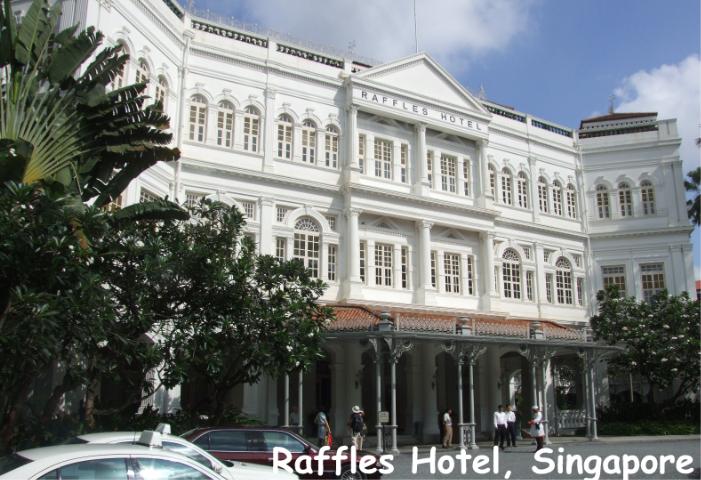 grand in every sense. I have been
lugging a cream linen jacket around the world for a month in case I might need
it at Raffles. I wore it on the
first few flights so that it wouldn’t get creased.
In the tropics I carried it in my hand-luggage, but it still got
crumpled. I ironed it at the hotel
in
Brisbane
and now I am wearing it again. I am
pleased to see that it is not the only cream linen jacket in the lobby, although
all the others seem to be worn by hotel staff.
I avoid eye contact with other guests lest they should hail me to give me
their drinks order. We go to the
reception desk and after a short discussion we are handed over to our personal
butler. He shows us to our suite in
the
Palm Court
, and now in the comfort of our own rooms we complete the registration cards.
We have an entrance lobby, with a dining area and a sitting area.
There are fresh strawberries on the dining table, magazines on the coffee
table in front of the TV. Outside,
overlooking the courtyard, we have a small table with two chairs.
The lobby leads into our bedroom, with two double beds, huge wardrobe,
tropical plants, another TV, and beyond which is a dressing room leading into
the bathroom. It is spacious and
sumptuous. We settle down into our
respective double beds.
grand in every sense. I have been
lugging a cream linen jacket around the world for a month in case I might need
it at Raffles. I wore it on the
first few flights so that it wouldn’t get creased.
In the tropics I carried it in my hand-luggage, but it still got
crumpled. I ironed it at the hotel
in
Brisbane
and now I am wearing it again. I am
pleased to see that it is not the only cream linen jacket in the lobby, although
all the others seem to be worn by hotel staff.
I avoid eye contact with other guests lest they should hail me to give me
their drinks order. We go to the
reception desk and after a short discussion we are handed over to our personal
butler. He shows us to our suite in
the
Palm Court
, and now in the comfort of our own rooms we complete the registration cards.
We have an entrance lobby, with a dining area and a sitting area.
There are fresh strawberries on the dining table, magazines on the coffee
table in front of the TV. Outside,
overlooking the courtyard, we have a small table with two chairs.
The lobby leads into our bedroom, with two double beds, huge wardrobe,
tropical plants, another TV, and beyond which is a dressing room leading into
the bathroom. It is spacious and
sumptuous. We settle down into our
respective double beds.
Wednesday 14 March
We wake up early again. This has
been the pattern of the tour. We
travel. We put our watches back.
We go to sleep early. We wake
up early. Here, we have our own
personal copy of the Straights Times on the doorstep, with a Raffles wrapper
inscribed: “If the news today should overwhelm, healing is available on level
three.” Breakfast is in the Tiffin
Room, where there are more waiters than diners.
They anticipate our every desire, and we make the mistake of emptying our
orange juice glasses. They are
re-filled without a word. ‘Spoilt
for choice’ is a hackneyed phrase, but it is appropriate for this breakfast.
How do you choose between three different kinds of fresh lychees?
Afterwards we are in our suite trying to decide what to do with our time in
Singapore
when the maid arrives bearing more fresh fruit (which we don’t recognise), a
message from Mr Kumar (our local rep) and an invitation to cocktails on Friday
evening (when we will be leaving for the airport).
We ask her about the Japanese Bonsai garden that Sue would like to visit
but she has never heard of it. She
rushes off to find out. We decide to
take a trip round the island tomorrow, so I call Mr Kumar to arrange it.
Whilst I am on the phone the maid returns with the news that the bonsai
garden is ‘in the west’ and a long way, and if we go by taxi we might find
it difficult to get a taxi back. We
decide against it. Today we will
look round some of the local shops and then go on a harbour cruise.
On the way to the mall (two minutes away) we are ‘picked up’ by an
optician who is very charming and helpful about dress code in malls (I
shouldn’t be wearing my shorts, although it is not actually forbidden)
enquires about our glasses (and is quite disparaging of western workmanship and
high prices) and then invites us to his shop for eye tests.
It’s a hard sell. We
decline. In the mall Sue finds Marks
& Spencer, home from home. The
optician was right about the dress code, though.
Most Singaporeans are very smart. The
only bare feet on show belong to the tourists.
In their shapeless T-shirts, baggy shorts, floppy hats and sandals (with
or without socks) we tourists in the mall look like rag-taggle refugees.
We take a taxi down to the Harbour Front, book a cruise, and then wander round
more shops in more malls. We are
amazed at the number of retail stores, and we haven’t even visited
Orchard Road
yet, or
China
Town
, or Little India. I reckon there
must be one retail store for every person in
Singapore
. I buy a shirt at
River
Island
and the salesman asks me how I prefer to be addressed.
We chat away, and he calls me Harvey as though we are old friends.
We have lunch at the Orange Lantern, a Vietnamese fast food restaurant,
another new experience.
We go to the cruise ticket desk at the appointed time, and then we are led
crocodile fashion through the mall, picking our way through the diners in a food
hall, to the waterfront itself. We
are opposite the
island
of
Sentosa
, which is reached by road bridge, monorail or cable car.
There is a huge stone lion on the island and the whole thing seems like a
Disney theme park. Our boat is the
Cheng Ho III, a replica of the Chinese junk from Admiral Zheng He’s fleet in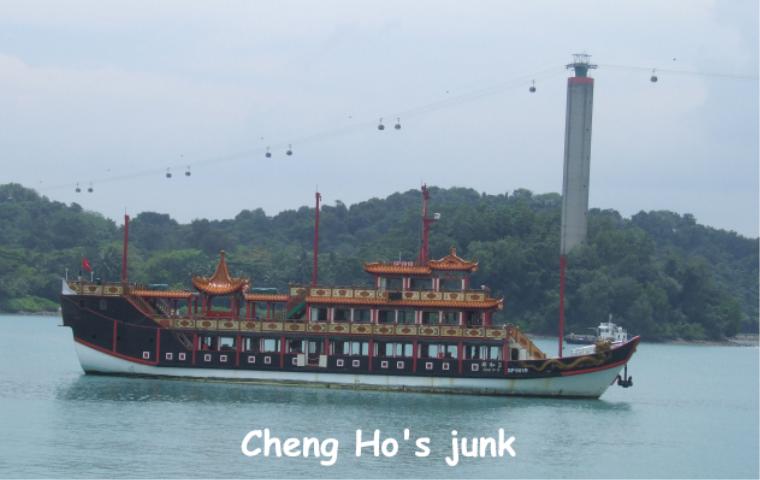 the 15th century. I am
delighted. I read his story in the
book 1421 by Gavin Menzies.
China
was the centre of the world, and every country paid homage (and tribute) to the
Emperor. Not content with that, the
Chinese wanted to become even richer and more powerful by recruiting more vassal
states and so they launched the largest fleet the world had ever seen ‘to
proceed all the way to the end of the earth’.
The fleet reached the
Americas
and
Australia
long before the Europeans, and Menzies’ book details the evidence (flora,
fauna, culture, language, and DNA) to prove his argument.
So why isn’t Zheng He more famous than Columbus and Magellan?
Because two months after he set sail a violent storm broke out over
Beijing
and the resulting fires destroyed large parts of the
Forbidden City
. Convinced that they were being
punished for some transgression against Heaven, the Chinese decided to renounce
their global ambitions, and when Zheng He returned two years later no-one was
interested in his travels and the fleet was left to rot.
But now we were boarding a replica of his junk.
the 15th century. I am
delighted. I read his story in the
book 1421 by Gavin Menzies.
China
was the centre of the world, and every country paid homage (and tribute) to the
Emperor. Not content with that, the
Chinese wanted to become even richer and more powerful by recruiting more vassal
states and so they launched the largest fleet the world had ever seen ‘to
proceed all the way to the end of the earth’.
The fleet reached the
Americas
and
Australia
long before the Europeans, and Menzies’ book details the evidence (flora,
fauna, culture, language, and DNA) to prove his argument.
So why isn’t Zheng He more famous than Columbus and Magellan?
Because two months after he set sail a violent storm broke out over
Beijing
and the resulting fires destroyed large parts of the
Forbidden City
. Convinced that they were being
punished for some transgression against Heaven, the Chinese decided to renounce
their global ambitions, and when Zheng He returned two years later no-one was
interested in his travels and the fleet was left to rot.
But now we were boarding a replica of his junk.
We sail (not really the right word, as we don’t have sails) round the southern
side of Sentosa, past miles of docks and hundreds of container ships, reminding
us that this is the busiest port in the world.
We travel out to
Kusu
Island
where we make a short stop to see a Chinese temple.
This might be a tourist trip but there are worshippers, and incense is
burning at the shrines.
We take a complimentary minibus back to the hotel just as it starts to rain,
although it doesn’t last. We
shower and then peruse the hotel guide wondering where to eat.
Raffles has around 20 bars and restaurants (not to mention arcades of
shops) but our first meal has to be a curry in the Tiffin Room.
‘Tiffin’ is the meal that British workers in
India
had when working out in the country during the day.
Three- or four-tiered tiffin boxes contained the ingredients for a light
meal: rice, dal, curry, and perhaps a sweet.
The food was usually prepared after the men had left, and a complex
network of Dabawallas would ensure that thousands of tiffin boxes reached the
right destinations.
The dress code is ‘smart elegant’ so I don my linen jacket again.
Sue is also elegantly smart in a black dress, but we are in the minority.
Most people haven’t made an effort, and you would be hard-put to
describe them as even smart casual. What
is the world coming to? Sue has a
sweet lassie and I have a Tiger beer with our curry.
The food is served modern buffet-style, but antique tiffin boxes are
displayed behind the counters.
Those who are born to it ignore restaurant staff just as they ignore servants.
Not being born to it, we re compelled to treat waiters like fellow
human-beings. We smile at them and
say thank you. This puts the waiters
in an awkward position, for it makes us all-square in the courtesy game and they
need to finish ahead. The waiter has
to give and we have to receive, and so when he pulls back my chair for me to sit
on, and I say thank you, he regains the initiative by saying “it’s been my
pleasure.” Hmm.
Thursday 15 March
We breakfast early as I am supposed to meet Mr Kumar at 7.45 to pay for the
trip. He doesn’t show, and I must
look worried because before long all the lobby staff keep coming up to rassure
me that Mr Kumar will probably be here soon.
We go back to the room to get ready, but back at the lobby there is still
no sign of our rep. We are due to be
picked up at 8.30, and without tickets we are not sure what will happen, but Mr
Kumar arrives minutes before our minibus and we set off wearing green badges for
the Island Tour. We have to hang
about at a clearing centre for a while, where most of the tourists are wearing
red badges for the City Tour. When
the green badges are herded on to the coach there are only ten of us.
Our guide for the day is Phillip, a Chinese Singaporean.
He gives a good commentary, not just about what we are passing, but also
about social issues, the government, the island’s future, relations with
Malaysia, and very movingly about the Japanese occupation.
But our first stop is pure kitsch. Two
brothers, who made their fortune from Tiger Balm, donated Haw Par Villa to the
people of
Singapore
. It is a huge theme park featuring
all that caught the brothers’ fancy, but the star attraction is a replica of
the underworld. We walk past a dozen
or so gruesome tableaux depicting the various tortures inflicted on the sinful,
each torture appropriate for the particular sin.
Most of the tortures involve some kind of physical mutilation.
We are not moved to take many photographs, and Phillip probably thinks we
are an unresponsive bunch.
Then we head north and see
Malaysia
, just two kilometres away across the Straights.
A road bridge joins the two countries now and Singaporeans like to drive
over to stock up on cheap Malaysian products.
The Singaporean government has had to impose limits on the quantity of
groceries you can bring back, and you are not allowed to leave the island by car
unless the petrol tank is three-quarters full.
Relations between the two countries have been strained, but pragmatically
they accept that being so close to each other they had better learn to get along
with it. Even so,
Malaysia
has put a stop to
Singapore
’s land reclaiming activities on this side of the island.
Two kilometres is near enough.
The next stop is the Kranji war memorial, unveiled in 1957.
Before we get off the coach Phillip tells us that his father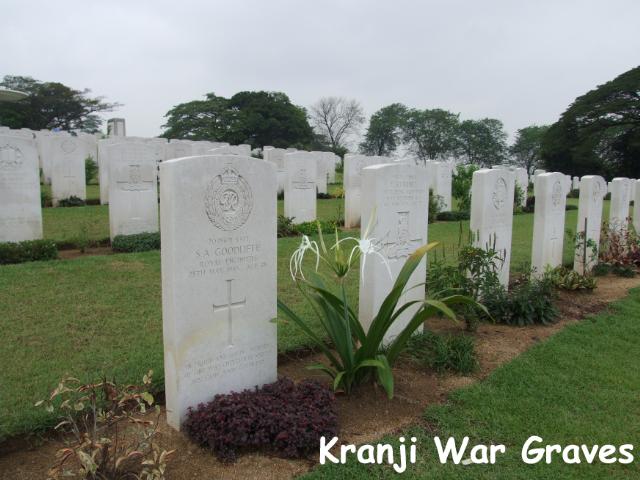 was caught
by the Japanese, and escaped. Otherwise
Phillip would not be here today. Without
pulling any punches he talks unemotionally about the Japanese brutality,
atrocities and murders during the occupation.
Few Japanese tourists come to this place, and he believes that today most
Japanese have no idea what happened here in the 1940’s.
I ask about the fall of
Singapore
, and the apparent ignorance of the western powers, and whether the locals knew
any better. We believed that
Singapore
could only be attacked from the sea, and so we built our defences accordingly.
The Japanese marched through the jungle down the Malayan peninsula and
came through the open back door. I’m
not sure Phillip
understood what I was getting at, but he says that no-one knew the Japanese were
coming until they were here. Perhaps,
for once, the politicians and military leaders couldn’t have been expected to
anticipate what happened, but with my hindsight I still blame them.
was caught
by the Japanese, and escaped. Otherwise
Phillip would not be here today. Without
pulling any punches he talks unemotionally about the Japanese brutality,
atrocities and murders during the occupation.
Few Japanese tourists come to this place, and he believes that today most
Japanese have no idea what happened here in the 1940’s.
I ask about the fall of
Singapore
, and the apparent ignorance of the western powers, and whether the locals knew
any better. We believed that
Singapore
could only be attacked from the sea, and so we built our defences accordingly.
The Japanese marched through the jungle down the Malayan peninsula and
came through the open back door. I’m
not sure Phillip
understood what I was getting at, but he says that no-one knew the Japanese were
coming until they were here. Perhaps,
for once, the politicians and military leaders couldn’t have been expected to
anticipate what happened, but with my hindsight I still blame them.
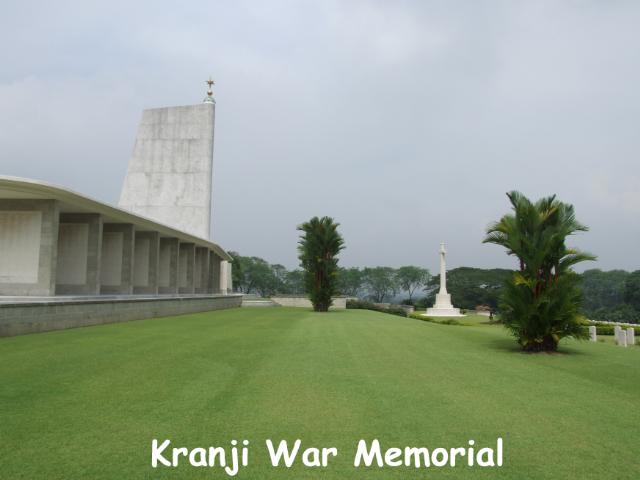 There are 4,000 headstones, white rows in green grass that seem to go on for
ever. Many, with no name, bear only
the words ‘Known unto God’. The
ground slopes upwards, and we walk through the headstones to a structure on top
of the hill. It consists of a series of
high walls, connected by a roof but open on two sides.
The walls bear the names of 20,000 servicemen whose bodies were never
recovered. The site is beautiful,
but unbearably sad, and I can’t hold back the tears.
I cry not just for what happened long ago on this small island but what
is still happening today, in
Iraq
, in
Afghanistan
, and will no doubt happen again in
Iran
and
North Korea
. “Their names liveth” but not
the lessons.
There are 4,000 headstones, white rows in green grass that seem to go on for
ever. Many, with no name, bear only
the words ‘Known unto God’. The
ground slopes upwards, and we walk through the headstones to a structure on top
of the hill. It consists of a series of
high walls, connected by a roof but open on two sides.
The walls bear the names of 20,000 servicemen whose bodies were never
recovered. The site is beautiful,
but unbearably sad, and I can’t hold back the tears.
I cry not just for what happened long ago on this small island but what
is still happening today, in
Iraq
, in
Afghanistan
, and will no doubt happen again in
Iran
and
North Korea
. “Their names liveth” but not
the lessons.
We have lunch at the Orchid Club, ten of us sitting at one round table in an
otherwise empty restaurant. We are
given a small traditional Chinese banquet, which is very good and, ten polite
strangers, we talk half-heartedly as we eat.
As always on these occasions the only thing we have in common is travel,
and so rather than talking about
Singapore
we talk about other tourist destinations from the past.
And there isn’t an orchid in sight, although we see plenty at our next
stop, the
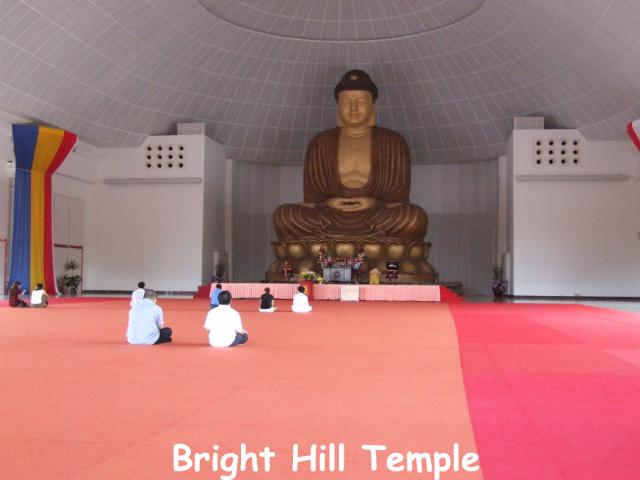 Buddhist
Bright
Hill
Temple
. This is a sprawling complex of
gardens and buildings, shrines, statues and prayer rooms.
The main prayer room is enormous, with a huge statue of Buddha dwarfing
the worshippers. It is all very
colourful, closer to Tibetan Buddhism than to our plain and simple local
Therevadan monastery. Phillip
explains some of the symbolism without revealing whether or not he is Buddhist.
Buddhist
Bright
Hill
Temple
. This is a sprawling complex of
gardens and buildings, shrines, statues and prayer rooms.
The main prayer room is enormous, with a huge statue of Buddha dwarfing
the worshippers. It is all very
colourful, closer to Tibetan Buddhism than to our plain and simple local
Therevadan monastery. Phillip
explains some of the symbolism without revealing whether or not he is Buddhist.
The last stop is the Changi Chapel and Museum.
The original chapel (built by Australian POW’s) was dismantled and
re-erected in
Canberra
, so this is a replica. In fact,
there is nothing left of the Japanese camp.
The POW buildings were demolished so that Changi (still a high security
prison) could be extended.
Singapore
still has the death penalty, and this is Death Row.
The chapel is simple, open air, and strangely I don’t find it as moving
as the Italian POW Chapel on Orkney. Perhaps
I am still numbed from Kranji. The
museum
is a sobering record of the invasion, surrender, occupation, imprisonment and
liberation, told by first-hand accounts of servicemen and civilians.
There are POW drawings and paintings, but not many artifacts.
Both the scale and the detail of what happened is unimaginable.
I don’t want to imagine it, and my mind recoils.
All I can take in is the 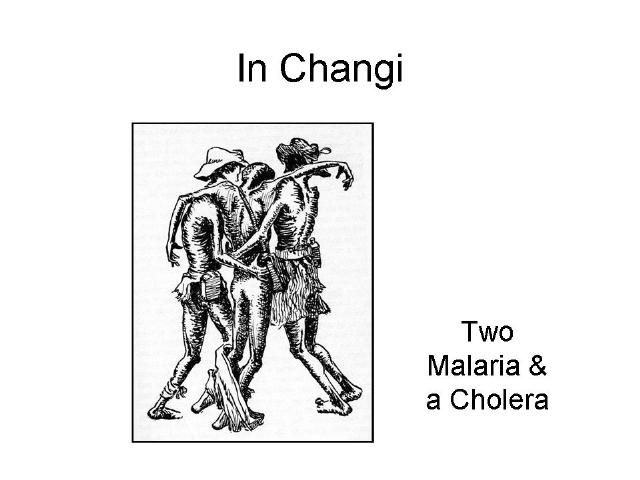 bravery shown by those who took risks to help
others, but I don’t think that I would do the same.
As for the atrocities, it would be nice to think that the human race
would never again sink so low, but here we are in another century and we stand
by whilst people are imprisoned without trial, and tortured, in the name of
freedom.
bravery shown by those who took risks to help
others, but I don’t think that I would do the same.
As for the atrocities, it would be nice to think that the human race
would never again sink so low, but here we are in another century and we stand
by whilst people are imprisoned without trial, and tortured, in the name of
freedom.
We drive back through Changi village, along
Long Beach
, and the coach stops at Raffles so that people can take a peek.
And Sue and I can get off, without going downtown for a minibus.
Sue has time for a sleep before dinner.
This is our last night, and so we go to the Long Bar, the place where the
Singapore Gin Sling was invented in 1915. From
the front, Raffles looks like a genteel and grand private old house, rising to a
modest three stories, incongruous amidst the sleek modern skyscrapers, but it
has a large footprint, so much so that the bustling city fades into the
background. Accompanied by the call
of mynah birds we have to walk through lush tropical garden courtyards with over
50,000 plants and round the block to get to the Long Bar.
Most visitors to
Singapore
manage to find time for two Raffles destinations: the lobby, where they take
photographs, and the Long Bar, for a gin sling, and so when we get there it’s
already crowded. Each table has a
dish of groundnuts, and the floor is littered with shells.
This strange tradition has survived in a city where litter (like chewing
gum) is otherwise non-existent. The
high ceiling has several lines of old-fashioned fans, the kind that would once
have been pulled by a punkah-wallah. These
are electric, and so they move in unison, creating a mesmerising effect.
We sit for a while before a waitress comes over.
She is not especially friendly, not what we have come to expect at
Raffles where the motto is “service like a gentle breeze will be your constant
companion.” I ask for a gin sling
and Sue has a planter’s punch. We
had been warned not to have cocktails here, and sure enough, they are
disappointing, both too sweet. But,
we couldn’t pass up on the experience. Then
we go to the Long Bar Steakhouse for a fillet mignon and the service like a
gentle breeze.
Friday 16 March
After breakfast I leave Sue and head off towards the historic part of the city.
I walk further than I need, but finally get to the river at the point 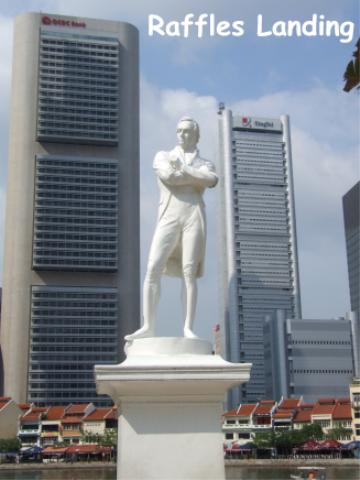 where Thomas Stamford Raffles first landed.
Son of a ship’s cook, born in
Jamaica
in 1781, Raffles made his way in life rather successfully.
After taking part in an expedition to capture Java in 1811 he became its
governor-general and, in an attempt to counter the Dutch presence in south-east
Asia he secured
Lion
Island
, Singapura, for the East India Company in 1819.
In fact, Raffles didn’t spend much time there but he is regarded as the
father of
Singapore
. His statue strikes a confident
pose, giving no doubt that he would have been equally at home wheeling and
dealing in the 21st century.
where Thomas Stamford Raffles first landed.
Son of a ship’s cook, born in
Jamaica
in 1781, Raffles made his way in life rather successfully.
After taking part in an expedition to capture Java in 1811 he became its
governor-general and, in an attempt to counter the Dutch presence in south-east
Asia he secured
Lion
Island
, Singapura, for the East India Company in 1819.
In fact, Raffles didn’t spend much time there but he is regarded as the
father of
Singapore
. His statue strikes a confident
pose, giving no doubt that he would have been equally at home wheeling and
dealing in the 21st century.
To know a city you should know its river, and so I book a cruise on a bumboat,
the kind of boat that has moved goods and people around since the days of
Raffles. They won’t let me get on
the first boat and I have to stand aside while a party of Japanese board.
Another boat arrives and sails away empty, but they let me get on the third
boat. I am the only tourist, and the
boatman heads off down river with me. There
is no commentary, and I wonder why I couldn’t have joined the Japanese party.
Perhaps they were worried that I might mention the war.
We stop at other landings and more tourists join us, and then a
commentary begins. I’m the only
white passenger but the commentary is in English.
A young Asian woman gets on by herself, no camera, no other sign of being
a tourist, and promptly falls asleep. The
boatman has to wake her when it’s her turn to get off.
We cruise past the jumble of old houses of Boat Quay, now restaurants and
bars, dwarfed by sleek high-rise office blocks and apartments.
Behind Raffles Landing are the graceful buildings of a colonial outpost:
Parliament House,
Victoria
Theatre
and Memorial Hall, and the Supreme Court. As
we approach the mouth of the river, we go past the Fullerton Hotel, once a
Victorian post office, and the futuristic gridshells of the Arts Centre.
One half of a big wheel stands on the edge of the river awaiting
completion, unlike the London Eye which was raised into position fully-formed.
The tour ends in front of the merlion (half fish, half lion) guarding the
mouth of the river. In fact, despite
its name,
Singapore
has no connection with lions. An
early dignitary saw a fierce-looking animal on arrival and called it “
Lion
Land
” assuming it must be a lion. As
the nearest lions are thousands of miles away it was probably a large unkempt
goat. The commentary explains that this is where most of the immigrants landed
in the old days, with nothing but their hopes and dreams and the desire to make
a success of their new lives. “Look
at the skyline of modern
Singapore
” the commentary continues, “to see what they achieved.”
I walk back to the hotel, taking a more direct route this time.
I stop to look at the memorial to the civilians who lost their lives
during the Japanese invasion and occupation.
There are no numbers. I
wonder if anyone knows how many died or if, as in the case of Iraqi civilian
deaths, these statistics are unimportant.
I meet up with Sue, who has been shopping and visiting the museum (without
leaving Raffles). We have lunch at
the New York Deli on
Seah Street
~ also part of the hotel complex ~ and then it’s time to check out of our
suite and have our cases collected. We
still have the afternoon, though, and we take a taxi to Little India.
Sue would like to buy a set of tiffin carriers for Ben but Little India
is for Indian shoppers rather than tourists.
We see utilitarian tiffin carriers, but nothing suitable as a present.
We take another taxi to
Orchard Road
, our last hope. This is where J G
Ballard lived as a boy, but this is nothing like the country road he described.
Orchard Road is now a monument to the god of retail therapy, with block
after block of shopping malls. We
don’t find what we want and empty-handed and somewhat jaded we take a taxi
back to the hotel. We collect our
overnight bags and shower and change at the Spa.
We eat at the Empire Café. I
have a vegetable curry with a couple of Tiger beers.
Sue asks for a vegetable chop suey, but she gets rice with what looks
like vegetable soup. We walk on to
the Deli for dessert and coffee.
We still have time on our hands so we sit a while in a small courtyard, gawp at
a cat-walk rehearsal (not for fashion, but for Samsonite luggage) and check out
the dress of guests at a wedding. We
are left with half an hour in the main lobby, amazed by the number of people who
come in, take photographs, and go out again.
The staff are quite good-humoured about it.
The hotel was declared a National Monument in 1987, so I suppose they can
expect to get photographed, and in a land where profit means everything, all
publicity is good publicity.
9.
Singapore
to
London
Heathrow Depart 23.20; Arrive
05.35
British
Airways Flight BA016. Flying time 14
hours. Distance 10,846 km
The mini-bus comes for us at 8.20 and Sue has an uncomfortable ride to the
airport. We are blasted with cold
air from the air-con and she has to shield her face with her handbag.
I get a text message from Malcolm confirming that Rogate Cars will
collect us tomorrow morning. We
check emails for the last time (free internet access at
Changi
Airport
) and then we are waiting again. If
only international travel didn’t involve waiting.
When we get on the plane it taxis down the runway as though on a dirt
track, with a lot of rattling and shaking. The
vibration doesn’t stop when we take off, and we get shaken and bumped for a
good part of our fourteen hour flight. Despite
the discomfort, we get quite a bit of sleep.
We didn’t wait for dinner, so by the time breakfast is served we are
pretty hungry, but breakfast is not a meal that airlines do well.
It is unappetising, and while we are forcing some of it down we are
subjected to the biggest bumps of the flight.
We land on time at Heathrow and as we go through passport control our driver
phones me to arrange where to meet. Before
we can do so I have to look for an ATM. I
seem to have packed my English currency. And
my door keys. When we get home I
have to wait for the car to leave before I retrieve the emergency key from its
secret hiding place (no, it’s not under the mat).
We have our second breakfast and Thora and Maclolm join us.
After almost 60 hours flying and more than 42,000 kilometres, it’s the
end of the journey.
So that's all, folks, unless you want to see what Sue
thought about it.
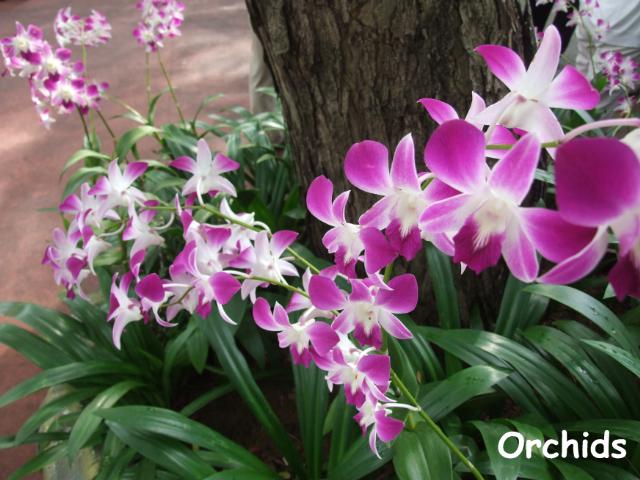 Images
of Harvey & Sue
Images
of Harvey & Sue
~ Page 1
~ Page 2
~ Page 3
Back
to Itinerary
 Bigger-Picture
Bigger-Picture Bigger-Picture
Bigger-Picture grand in every sense. I have been
lugging a cream linen jacket around the world for a month in case I might need
it at Raffles. I wore it on the
first few flights so that it wouldn’t get creased.
In the tropics I carried it in my hand-luggage, but it still got
crumpled. I ironed it at the hotel
in
grand in every sense. I have been
lugging a cream linen jacket around the world for a month in case I might need
it at Raffles. I wore it on the
first few flights so that it wouldn’t get creased.
In the tropics I carried it in my hand-luggage, but it still got
crumpled. I ironed it at the hotel
in  the 15th century. I am
delighted. I read his story in the
book 1421 by Gavin Menzies.
the 15th century. I am
delighted. I read his story in the
book 1421 by Gavin Menzies.
 was caught
by the Japanese, and escaped. Otherwise
Phillip would not be here today. Without
pulling any punches he talks unemotionally about the Japanese brutality,
atrocities and murders during the occupation.
Few Japanese tourists come to this place, and he believes that today most
Japanese have no idea what happened here in the 1940’s.
I ask about the fall of
was caught
by the Japanese, and escaped. Otherwise
Phillip would not be here today. Without
pulling any punches he talks unemotionally about the Japanese brutality,
atrocities and murders during the occupation.
Few Japanese tourists come to this place, and he believes that today most
Japanese have no idea what happened here in the 1940’s.
I ask about the fall of  There are 4,000 headstones, white rows in green grass that seem to go on for
ever. Many, with no name, bear only
the words ‘Known unto God’. The
ground slopes upwards, and we walk through the headstones to a structure on top
of the hill. It consists of a series of
high walls, connected by a roof but open on two sides.
The walls bear the names of 20,000 servicemen whose bodies were never
recovered. The site is beautiful,
but unbearably sad, and I can’t hold back the tears.
I cry not just for what happened long ago on this small island but what
is still happening today, in
There are 4,000 headstones, white rows in green grass that seem to go on for
ever. Many, with no name, bear only
the words ‘Known unto God’. The
ground slopes upwards, and we walk through the headstones to a structure on top
of the hill. It consists of a series of
high walls, connected by a roof but open on two sides.
The walls bear the names of 20,000 servicemen whose bodies were never
recovered. The site is beautiful,
but unbearably sad, and I can’t hold back the tears.
I cry not just for what happened long ago on this small island but what
is still happening today, in  Buddhist
Buddhist bravery shown by those who took risks to help
others, but I don’t think that I would do the same.
As for the atrocities, it would be nice to think that the human race
would never again sink so low, but here we are in another century and we stand
by whilst people are imprisoned without trial, and tortured, in the name of
freedom.
bravery shown by those who took risks to help
others, but I don’t think that I would do the same.
As for the atrocities, it would be nice to think that the human race
would never again sink so low, but here we are in another century and we stand
by whilst people are imprisoned without trial, and tortured, in the name of
freedom. where Thomas Stamford Raffles first landed.
Son of a ship’s cook, born in
where Thomas Stamford Raffles first landed.
Son of a ship’s cook, born in  Images
of Harvey & Sue
Images
of Harvey & Sue